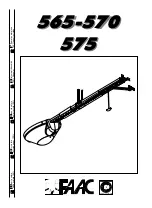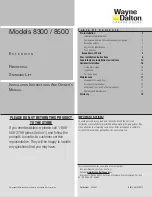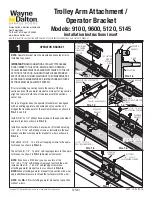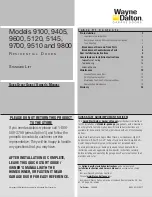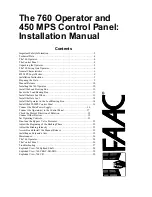
2. Maintaining a tight grip on the winding rod rotate it slowly in the proper direction, as
shown below.
3. If there is any slippage of the winding rod in the winding cone socket, reverse the direction
of winding and return the cone to its original position. Remove the winding rod from the
winding cone socket. Reseat the winding rod in the socket. Start over at Step #1.
4. When the winding rod is vertical above the winding cone, insert another winding rod into
one of the other sockets, being careful to seat it snugly and at full socket depth.
5. Hold the spring with the second winding bar, and remove the first.
6. Repeat Steps #2 through #5 until the complete turns have been applied.
IMPORTANT:
AFTER WINDING THE SPRING(S), TIGHTEN THE SET SCREWS IN THE WINDING
CONE TO 14-15 FT-LBS OF TORQUE (ONCE SET SCREWS CONTACT THE TORSION SHAFT,
TIGHTEN SCREWS AN ADDITIONAL ONE FULL TURN).
HIGH SPRING TENSION CAN CAUSE
SERIOUS INJURY OR DEATH.
DO NOT
adjust, repair or remove springs or parts to
which springs are connected, such as steel brack-
ets, cables, wood blocks, fasteners or other parts of
the counterbalance system.
Adjustments or repairs must
ONLY
be made by a
trained door systems technician using proper tools
and instructions.
DO NOT
remove, cover or paint over this tag. Prod-
uct user should inspect this tag periodically for
legibility and should order a replacement tag from
the door manufacturer, as needed.
©Copyright 2010 Overhead Door Corporation
102081 REV2 06/24/2010
HIGH SPRING TENSION CAN CAUSE
SERIOUS INJURY OR DEATH.
DO NOT
adjust, repair or remove springs or parts to
which springs are connected, such as steel brack-
ets, cables, wood blocks, fasteners or other parts of
the counterbalance system.
Adjustments or repairs must
ONLY
be made by a
trained door systems technician using proper tools
and instructions.
DO NOT
remove, cover or paint over this tag. Prod-
uct user should inspect this tag periodically for
legibility and should order a replacement tag from
the door manufacturer, as needed.
©Copyright 2010 Overhead Door Corporation
102081 REV2 06/24/2010
Torsion shaft
Winding
cone
Torsion
spring(s)
Approved
winding
rod
Set screws
IMPORTANT:
CHECK THE WARNING
TAG(S) ATTACHED TO THE SPRING(S)
FOR THE REQUIRED NUMBER OF
COMPLETE TURNS, TO BALANCE
YOUR DOOR.
Warning
tag(s)
Approved winding rod
Torsion spring(s) should be wound in the direction the end coil points.
Spring
coils
Attaching Rear Back Hangs
23
IMPORTANT:
HOLD THE DOOR DOWN TO PREVENT IT FROM RISING UNEXPECTEDLY IN THE
EVENT THE SPRING(S) WERE OVER-WOUND AND CAUTIOUSLY REMOVE LOCKING PLIERS
FROM VERTICAL TRACKS.
Raise the door until the top section and half of the next section are in the horizontal track
radius. Do not raise door any further since rear of horizontal tracks are not yet supported.
WARNING
RAISING DOOR INTO THE LOOSE HORIZONTAL TRACKS CAN RESULT IN
DOOR FALLING AND CAUSE SEVERE OR FATAL INJURY.
Clamp a pair of locking pliers onto the vertical tracks just above the second track roller on
one side, and just below the second track roller on the other side. This will prevent the door
from raising or lowering while installing the rear back hangs.
Using the chart below, select the appropriate perforated angle (may not be supplied). Fabri-
cate and install rear back hangs, as shown.
Perforated Angle Gauge Weight Limitations:
Perforated Angle Gauge
Door Balance Weight
2” x 2” x 12 Gauge
800 lbs. to 1600 lbs.
1-1/4” x 1-1/4” x 13 Gauge
305 lbs. to 610 lbs.
1-1/4” x 1-1/4” x 15 Gauge
220 lbs. to 440 lbs.
1-1/4” x 1-1/4” x 16 Gauge
175 lbs. to 350 lbs.
NOTE:
If an opener is installed, position horizontal tracks one hole above level when securing
it to the rear back hangs.
WARNING
MAKE SURE BACK HANGS ARE BRACED SUFFICIENTLY TO RESIST ANY
MOTION DURING SPRING APPLICATION AND DOOR TRAVEL. IF BACK
HANGS PIVOT OR DEFLECT, ADD REINFORCEMENT UNTIL THEY REMAIN
FIRM AND STATIONARY. ANY BACK HANG THAT IS BENT MUST BE
REPLACED.
WARNING
KEEP HORIZONTAL TRACKS PARALLEL AND WITHIN 3/4” TO 7/8” FROM
DOOR EDGE, OTHERWISE DOOR COULD FALL, RESULTING IN SEVERE OR
FATAL INJURY.
IMPORTANT:
DO NOT SUPPORT THE WEIGHT OF THE DOOR ON ANY PART OF THE REAR
BACK HANGS THAT CANTILEVERS 4” OR MORE BEYOND A SOUND FRAMING MEMBER.
NOTE:
If rear back hangs are to be installed over drywall, use (2) 5/16” x 2” hex head lag
screws and make sure lag screws engage into solid structural lumber.
WARNING
FAILURE TO ASSEMBLE AND ATTACH REAR BACK HANGS PROPERLY
ACCORDING TO THE ABOVE INSTRUCTIONS MAY RESULT IN DOOR
FALLING WHEN RAISED, CAUSING SEVERE OR FATAL INJURY.
NOTE:
Perforated angle must be attached to sound framing members and
nails should not
be used
.
90°
(3) 5/16”
Bolts and nuts
(3) 5/16” Bolts and
(3) 5/16” nuts
Perforated
angle
5/16” Hex nut
5/16”-18 x 1-1/4”
Hex bolt
Perforated angle bolted
using (2) 5/16” x 1-5/8”
hex head lag screws to
ceiling member and
parallel to door
Horizontal track
NOTE:
Repeat the same
process for right hand side.
5/16” Hex nuts
5/16”-18 x 1-1/4”
Hex bolts
Perforated angle bolted
using (2) 5/16” x 1-5/8”
hex head lag screws to
ceiling member and
parallel to door
Horizontal track
NOTE:
Repeat the same
process for right hand side.
10















